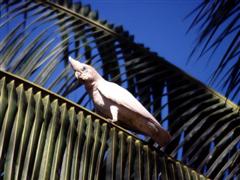Corella - Little
Scientific Name: Cacatua pastinator sanguinea
Tue, 15th July, 2025 - 10:15 pm GMT
Sponsor Ads:

Alternative Name
Scientific Name: Cacatua pastinator sanguineaBasic Info
With grayish white feathers and curved, short white beaks, Little Corellas are attractive birds. Their periopthalmic rings are blue-gray, and they have pale red coloration about their beaks. Their feathers occasionally have a pinkish orange tinge to their bases, which is especially evident about the bird?s lores. The only difference between the Little Corella sexes is in the size of the body or head, though often it is still very difficult to tell and DNA sexing is required.
Health
Specific Care Information: Relative Care Ease: Average Little Corellas often pluck their feathers, so be sure to provide lots of toys and branches for them to chew on, fending off boredom. Because they spend so much time on the ground, Little Corellas are prone to intestinal worms and fungal infections. The majority of these can be prevented by proper hygiene. Psittacine Beak and Feather Disease is another common problem and is incurable. Birds with the disease have black feathers and fragile beaks, which do not heal. The disease is transmitted through feces, and infected birds must be put down. Breeding In the wild, the majority of Little Corellas breed between June and October, though there is no specific breeding season. In captivity, Little Corellas will need a nesting log of about a meter in length with a 35 centimeter internal diameter. It may be placed vertically or at a slant, and you should provide peat moss, dirt and wood shavings as nesting material. Make about a six to eight inch layer of nesting, as many Little Corellas will like to excavate their nests somewhat. Although Little Corellas have bred at earlier ages, they usually mate for the first time at four or five years and many pairs will not clutch until they are six or seven. A clutch consists of one to three eggs, which incubate for approximately 26 days. The young fledge at around 56 days of age.Habitat
N/ABehavior
With pristine appearances and lovely personalities, the Little Corella makes a wonderful pet and a good friend. The Little Corella generally has a good attitude and can be taught to talk and do tricks. These lovely birds welcome your attention and affection, but be careful; as with many parrots they are escape artists. Little Corellas love to chew and can often bite their way out of wire cages. They like open grassland or open forest and are usually found near water. Little Corellas are very vocal in the wild and do not have a set home range; rather, they are nomadic. In captivity, your Little Corella needs fresh water at all times. They do very well when kept in pairs. A single bird will do fine in a cage of at least 800 by 600 by 1200 millimeters in dimension. Little Corellas will thrive, however, in large aviaries with steel frames and very heavy wire. These should be about two by two by six meters in dimension. In the wild, Little Corellas build their nests in holes of tall trees or hollow branches and line them with soft wood shavings. The courtship display of Little Corellas is typical of Cockatoos; the male bobs his head and screeches at his intended female while spreading his wings and tail and holding his crest high. Little Corellas intending to breed will pay a great deal of attention to their nesting site, loitering around the entrance and inside, and chewing on the entrance.Origin
AustraliaHistory
Little Corellas are native to Australia and the surrounding islands. There are a number of subspecies of this bird both in the wild and in captivity. They have long been valued as sweet, friendly pets. Little Corellas have been crossed with Galahs, Major Mitchell Cockatoos, Gang Gang Cockatoos and Sulphur-crested Cockatoos.Common Foods
In the wild, Little Corellas eat seeds, insects, bulbs and fruit.Sponsor Ads:
"Stupid people surround themselves with smart people. Smart people surround themselves with smart people who disagree with them." -- Aaron Sorkin
Corella - Little
Coded by: BGID® | ALL RIGHTS RESERVED Copyright © 2000-2025
Disclaimer | Privacy | Report Errors / Contact | Credits








 President of the United States of America - Real Estate mogul, Pageant owner and now one of the most controversial men in political history.
President of the United States of America - Real Estate mogul, Pageant owner and now one of the most controversial men in political history.  Global warming has been in and out as the "latest" hot topic for many years. It is, according to modern scientists, the result of man-made industrial pollutants, clearing forested areas, agriculture, etc. But now they are thinking it started way before the Industrial Revolution...
Global warming has been in and out as the "latest" hot topic for many years. It is, according to modern scientists, the result of man-made industrial pollutants, clearing forested areas, agriculture, etc. But now they are thinking it started way before the Industrial Revolution...  Politician, US Vice President and President of the USA - Joseph Robinette Biden Jr.
Politician, US Vice President and President of the USA - Joseph Robinette Biden Jr.  versus
versus  Russia: 'The Evil Empire'? Are they all that bad or is it just the USA trying to portray Russia as bad because they are a world power with land bigger and a society very different from the USA ideal?
Russia: 'The Evil Empire'? Are they all that bad or is it just the USA trying to portray Russia as bad because they are a world power with land bigger and a society very different from the USA ideal? 
 Corona virus
Corona virus 
 Users with wide screen monitors can benefit from more content on every page.
Users with wide screen monitors can benefit from more content on every page.